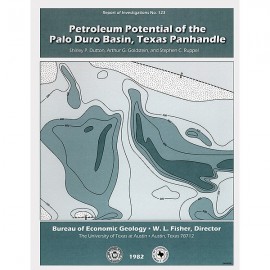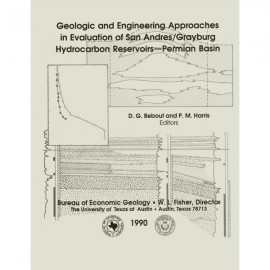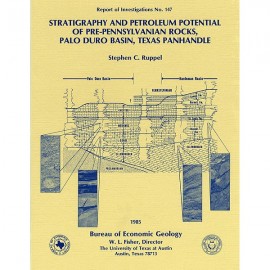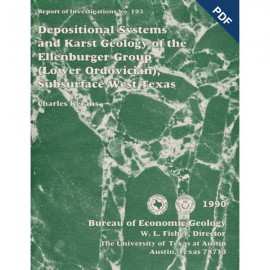Reports of Investigations
-
Books & Reports
- Reports of Investigations
- Guidebooks
- Udden Series
- Geological Circulars
- Down To Earth
- Atlases of Major Oil and Gas Reservoirs
- Texas Memorial Museum Publications
- Environmental Geologic Atlas of the Texas Coastal Zone
- Mineral Resource Circulars
- Other Reports
- Seminars and Workshops
- Handbooks
- Submerged Lands of Texas
- Symposia
- Annual Reports
- Open File Reports
-
Maps & Cross Sections
- Thematic Maps
- Miscellaneous Maps, Charts & Sections
- Geologic Atlas of Texas
- STATEMAP Project Maps
- Geologic Quadrangle Maps
- Cross Sections
- Highway Geology Map
- Energy and Mineral Resource Maps
- Shoreline Change and Other Posters
- Wilcox Group, East Texas, Geological / Hydrological Folios
- Bouguer Gravity Atlas of Texas
- River Basin Regional Studies
- Featured Maps
- Posters
- Teachers & the Public
-
Geological Society Publications
- Gulf Coast Association of Geological Societies
- Alabama Geological Society
- Austin Geological Society
- Corpus Christi Geological Society
- Houston Geological Society
- Lafayette Geological Society
- Mississippi Geological Society
- New Orleans Geological Society
- South Texas Geological Society
- GCS SEPM Publications
- Historic BEG & UT Series
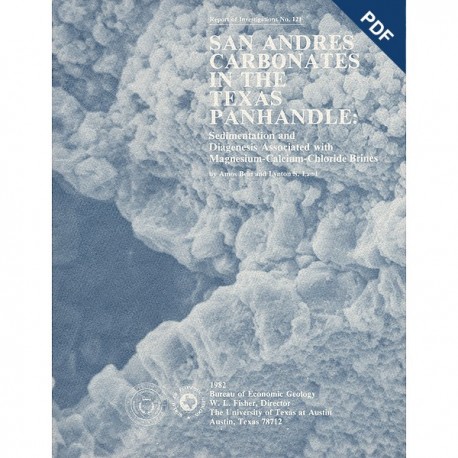
San Andres Carbonates... Texas Panhandle...Digital Download
RI0121D
A free, digital version of this publication can be found on: Texas ScholarWorks
To purchase a print version (if available): RI0121
RI0121D. San Andres Carbonates in the Texas Panhandle: Sedimentation and Diagenesis Associated with Magnesium-Calcium-Chloride Brines, by Amos Bein and L. S. Land. 48 p., 27 figs., 9 tables, 2 appendices, 1982. doi.org/10.23867/RI0121D. Downloadable PDF.
To purchase this publication in book format, please order RI0121.
ABSTRACT
The San Andres evaporitic sequence in the Palo Duro Basin comprises several thick carbonate units in its lower part and many thin units in its upperpart. To the south, across the Northern Shelf of the Midland Basin, evaporites pinch out and carbonates predominate. Six lithofacies were differentiated in the Palo Duro and Northern Shelf carbonates: dolomudstone, pellet-oolite packstone-grainstone, filamentous (Girvanella-like) grainstone, sponge spicule packstone, wispy-laminated crinoid packstone, and skeletal packstone-grainstone. Facies distribution was controlled by water-body salinity, which increased from south to north. Within the Palo Duro Basin, the carbonates in the upper part of the sequence differ from those in the lower part in that the former lack skeletal lithofacies and have higher manganese, iron, and terrestrial organic matter content. Bromide (Br) content in halite in the lower part of the sequence is consistently high, whereas halite in the upper part is mostly depleted in bromide. Strontium (Sr) in dolomite, calcite and anhydrite, δ18O, δI3C values, and early diagenetic oxidizing conditions deduced from high pristane/phytane ratios are about the same throughout the entire San Andres Formation in the Palo Duro Basin. Depleted δI3 values in dolomites associated with low pristine/phytane ratios in the Northern Shelf formed under more reducing conditions in which organically derived carbon in the carbonates increased because of sulfate-reducing bacterial activity. Sodium/chloride and potassium/chloride ratios attributed to liquid inclusions in almost all carbonates are characteristic of marine brines evaporated beyond the level of halite saturation. Sodium content in the dolomite lattice is generally low and increases from north to south at the same stratigraphic levels.
Varied sedimentologic and geochemical properties of the rocks throughout the area reflect different primary depositional regimes. Properties that do not vary are attributed to diagenetic modification of the rocks in contact with brines having similar compositions. The lower part of the formation was deposited in a broad shelf basin or lagoon sufficiently deep to maintain long periods of steady-state circulation. During these periods neither halite dissolution nor potash-magnesia mineral precipitation occurred. The upper part of the formation was deposited in smaller water bodies sensitive to inflow fluctuations. Increased proportion of meteoric water in the depositional environment during this period is evidenced by high content of manganese, iron, and terrestrial organic matter, and the meteoric water was a source of dissolved carbonate for the deposition of many of the thin carbonate units.
Diagenesis of the San Andres carbonates occurred in contact with saline magnesium-calcium-chloride brines, which evolved from seawater by anhydrite and halite precipitation. Skeletal mold formation and subsequent anhydrite cementation, dolomitization, and high-strontium calcite cementation associated with celestite precipitation are all cogenetic processes controlled by this brine-rock interaction. The δ18O composition of dolomite, calcite, and chert indicates apparent equilibrium relations with the same solution. Possible low temperatures of 40° to 450° C (105° to 110° F) imply δ18O of such a solution to be about 2 to 3‰.The somewhat light δ18O composition of the proposed halite-saturated brine may have resulted from the reversal in the positive correlation between δ18O and increased evaporation in highly saline brines. San Andres carbonates in the Palo Duro Basin that were diagenetically altered in a halite-saturated magnesium-calcium chloride brine were plugged by precipitating salt and remain unchanged and isolated in a closed sedimentary basin. The Northern Shelf carbonates were modified by similar brines intermittently undersaturated with respect to halite because of mixing with seawater. As a result, some original porosity remained, and pressure solution occurred in the more deeply buried and more skeletal-rich sequence.
Keywords: anhydrite, carbonate lithofacies, geochemistry, lithofacies, Lamb County, Swisher County, Randall County, Panhandle, Texas, dolomudstones, Texas, Palo Duro Basin, San Andres Formation, Northern Shelf
CONTENTS
ABSTRACT
INTRODUCTION
GEOLOGIC SETTING
METHODS OF STUDY
Technique
Interpretation
CARBONATE LITHOFACIES
Dolomudstones
Pellet-oolite packstones and grainstones
Sponge spicule packstones
Filamentous (Girvanella-like) grainstones and boundstones
Wispy-laminated crinoid packstones
Skeletal packstones and grainstones
ANHYDRITE-DOLOMITE ASSOCIATION AND SILICIFICATION
Dolomite-anhydrite intergrowth
Anhydrite nodules
Replacement anhydrite
Blocky anhydrite cement
Silicification of anhydrite
GEOCHEMICAL DATA
Organic matter associated with carbonates
Trace elements in associated evaporites
Bromide in halite
Strontium in anhydrite
Sodium and chloride in carbonates
Potassium in carbonates
Strontium in carbonates
Iron and manganese in carbonates
Other trace elements in carbonates
Stoichiometry and order of dolomite crystals
Stable isotopes in carbonates and cherts
DISCUSSION
CONCLUSIONS
ACKNOWLEDGMENTS
REFERENCES
APPENDICES
Figures
1. Location and isopach map of the San Andres Formation in the study area
2. North-south cross section through the study area
3. Lithofacies distribution of SR2 rock units
4. Lithofacies distribution of LSR3 rock units
5. Lithofacies distribution of LSR4 rock units
6. Lithofacies distribution of YSR56 rock units
7. Photomicrographs of dolomudstones
8. Photomicrographs of oolitic and pelletoidal rocks
9. Photomicrographs of oolites and sponge spicule packstones
10. Photomicrographs of Girvanella-like grainstones and boundstones
11. Photomicrographs of skeletal packstones
12. Photomicrographs of replacement anhydrite fabrics
13. Gas chromatogram of saturated hydrocarbons in Swisher County core
14. Gas chromatogram of saturated hydrocarbons in S4 and L4 rock units
15. Relation between pristane/ phytane ratio and total organic carbon (TOC) in Swisher County and Lamb County samples
16. Relation between sodium/ chloride and chloride in YSR56 samples
17. Relation between sodium/ chloride and chloride in LSR4 samples
18. Relation between sodium/ chloride and chloride in SR23 samples
19. Relation between sodium/chloride and chloride mean values of each unit
20. Relation between potassium and aluminum in all San Andres rocks
21. Frequency histogram of strontium content in dolomite samples
22. Relation between aluminum and manganese in rock samples
23. Relation between aluminum and iron in rock samples
24. Relation between manganese and iron intercept value for zero aluminum
25. Hexagonal unit cell parameters ao and co calculated from X-ray diffraction
26. Relation between δ18O and δ13C in dolomites and calcites
27. Relation between δ18O and manganese in stratigraphically related samples
Tables
1. Rock unit symbols used in this study
2. Pristane/phytane ratio and total organic carbon in San Andres carbonates
3. Bromide content in halite and strontium and manganese content in anhydrite nodules and massive anhydrite beds
4. Carbonate constituents, trace elements, and stable isotopes in San Andres carbonates
5. Chemical composition of water used to leach ground dolomite samples
6. δ18O values in quartz separated from partially silicified anhydrite nodules and sponge spicule packstones
7. δ18O equilibrium relation between water and carbonates as a function of temperature
8. δ18O equilibrium relation between water and chert as a function of temperature
9. δ18O and δ13C values in the Seven Rivers Formation, Guadalupe Mountains
Citation
Bein, Amos, and Land, L. S., 1982, San Andres Carbonates in the Texas Panhandle: Sedimentation and Diagenesis Associated with Magnesium-Calcium-Chloride Brines: The University of Texas at Austin, Bureau of Economic Geology, Report of Investigations No. 121, 48 p.

